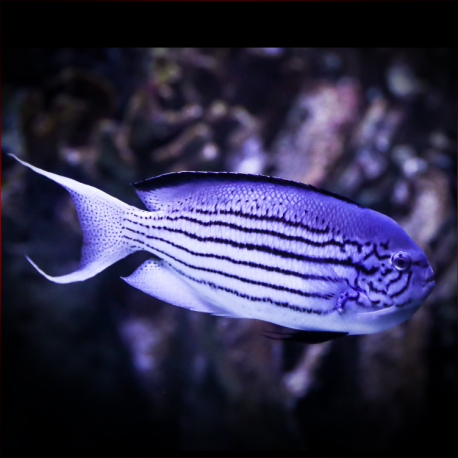More info
Datasheet
| Minimum Tank Size | 700 litres / 184.92 US gallons |
| Maximum Size | 25.0cm / 9.84inches |
| Reef Compatible | Reef safe with caution |
| Temperament | Might be aggressive towards similar species |
| Temperature | 22.2°C / 71.96°F - 25.6°C / 78.08°F |
| Specific Gravity | 1.020-1.025 |
| Carbonate Hardness | 8-12 |
| pH | 8.1-8.4 |
General Description
The Genicanthus, or Blackstriped angelfish, is characterized by its lyre-like tail and its feeding habits focused on zooplankton in open waters. Unlike other Angelfish species, they primarily feed on zooplankton, microalgae, fish eggs, and small invertebrates. The species is known to do well in coral aquariums as they seldom target corals, with occasional exceptions like Xenia. Males can display aggression towards each other, while females can coexist peacefully, even with other species.
Aquarium Suitability
Highly suitable for most aquariums, the Genicanthus requires a tank size of at least 700 liters. The ideal setup includes a pair (one male and one female) or one male with several females. Frequent feeding is crucial, especially when newly introduced, and the fish must be provided with hiding spots among live rocks. They thrive in spacious aquariums that allow ample swimming space and should be added simultaneously to avoid aggression.
Care and Hardiness
Known for their hardiness, these angelfish can adapt well to well-established aquariums and are herbivorous, requiring a varied diet rich in algae. They may initially display shyness in a new environment but can acclimate with time. The species can change gender from female to male, with females transitioning when a male role is needed. Providing dim lighting during acclimatization and ensuring high water quality are essential for their care.
Reef Suitability
Considered reef-safe with caution, the Blackstriped angelfish can be housed in coral aquariums if suitable coral species are chosen. They are less likely to feed on corals but may occasionally target soft corals and LPS. The fish benefits from a well-run aquarium with ample algae for grazing, supplemented by algae-rich foods like Spirulina if necessary.
Aquarium Setup
The ideal aquarium setup for Genicanthus includes a well-established tank with sufficient space for swimming and hiding places among live rocks. A tank size of at least 700 liters is recommended, with dimmed lighting initially to aid acclimatization. Maintaining high water quality, providing a varied diet, and ensuring there are no aggressive tank mates are crucial for their well-being.
Behaviour
These angelfish can exhibit aggression towards similar species, especially males towards each other. However, females generally coexist peacefully, even with other fish species. The species is known for its swimming behavior and requires a spacious environment to thrive.
Feeding and Diet
The Blackstriped angelfish primarily feeds on zooplankton, microalgae, fish eggs, and small invertebrates. Their diet should be supplemented with larger crustaceans, microalgae like Spirulina, and small crustaceans such as krill, mysis, and artemia. Frequent feeding, especially during the acclimatization period, is crucial for their health.
Dimorphism
Genicanthus lamarck possesses distinct dimorphism, with females being able to change into males in the absence of a dominant male. This species functions best in pairs (one male, one female) or with one male and multiple females. Females can revert to their original gender if needed, maintaining a balanced social structure within the group.
Habitat and Distribution
These angelfish are found in the Indo-West Pacific, ranging from the Indo-Malayan region eastward to Vanuatu, north to southern Japan, and southward to the Great Barrier Reef. They typically inhabit deep waters and are known for their hunting of zooplankton in open areas, showcasing their unique lyre-like tail and distinctive feeding behavior.

